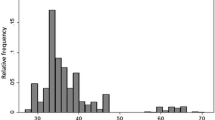Abstract
GATA3 is an enriched transcription factor in mammary epithelium. To date, there has been no study on the relationship between microsatellites in the GATA3 gene and breast cancer risk. In this study, we investigated the existence of polymorphisms in the cytosine–thymine (CT) dinucleotide repeat in intron 3 of the GATA3 gene and its association with breast cancer risk. A case–control study of 206 breast cancer patients and 262 controls was conducted in Iranian women. Several different CT repeat alleles of GATA3 were detected in both the patients and controls. The frequencies of 17 and 18 alleles in patients were significantly lower than controls. Our findings demonstrate that women who carry 17-CT (OR = 0.5; p = 0.003) or 18-CT (OR = 0.41, p = 0.02) alleles of GATA3 gene are at lower risk of developing breast cancer. The highest protection against breast cancer was observed with heterozygotes of 16/17 repeats (OR = 0.12, p = 0.02). Also, the presence of the 17-CT allele has a positive relation with estrogen receptor expression. However, we found that the allelic length of GATA3 polymorphisms had no significant effect on the age onset or grade of the disease, as well as the expression of progesterone receptors and HER2.
Similar content being viewed by others
References
Dumitrescu RG, Cotarla I. Understanding breast cancer risk- where do we stand in 2005. J Cell Mol Med. 2005;9:208–21.
Alvarez RH. Present and future evolution of advanced breast cancer therapy. Breast Cancer Res. 2010;12(Suppl 2: S1):1–18.
Mousavi SM, Montazeri A, Mohagheghi MA, Jarrahi AM, Harirchi I, Najafi M, Ebrahimi M. Breast cancer in Iran: an epidemiological review. Breast J. 2007;13:383–91.
Mousavi SM, Gouya MM, Ramazani R, Davanlou M, Hajsedeghi N, Seddighi Z. Cancer incidence and mortality in Iran. Ann Oncol. 2009;20:556–63.
Yavari P, Mosavizadeh M, Sadrol-Hefazi B, Mehrabi Y. Reproductive characteristics and the risk of breast cancer—a case-control study in Iran. Asian Pac J Cancer Prev. 2005;6:370–5.
Harirchi I, Karbakhsh M, Kashefi A, Momtahen AJ. Breast cancer in Iran: result of a multi-center study. Asian Pac J Cancer Prev. 2004;5:24.
Zheng R, Blobel GA. GATA transcription factors and cancer. Genes Cancer. 2010;1:1178–88.
Kouros-Mehr H, Slorach EM, Sternlicht MD, Werb Z. GATA-3 maintains the differentiation of the luminal cell fate in the mammary gland. Cell. 2006;127:1041–55.
Ciocca V, Daskalakis C, Ciocca RM, Ruiz-Orrico A, Palazzo JP. The significance of GATA3 expression in breast cancer: a 10-year follow-up study. Hum Pathol. 2009;40:489–95.
Yan W, Cao QJ, Arenas RB, Bentley B, Shao R. GATA3 inhibits breast cancer metastasis through the reversal of epithelial-mesenchymal transition. J Biol Chem. 2010;285:14042–51.
Mehra R, Varambally S, Ding L, Shen R, Sabel MS, Ghosh D, Chinnaiyan AM, Kleer CG. Identification of GATA3 as a breast cancer prognostic marker by global gene expression meta-analysis. Cancer Res. 2005;65:11259–64.
Naylor MJ, Qrmandy CJ. Gata-3 and mammary cell fate. Breast Cancer Res. 2007;2007(9):302–3.
Wilson BJ, Giguere V. Meta-analysis of human cancer microarrays reveals GATA3 is integral to the estrogen receptor alpha pathway. Mol Cancer. 2008;7:49.
Miller SA, Dykes DD, Polesky HF. A simple salting out procedure for extracting DNA from human nucleated cells. Nucleic Acids Res. 1988;16:1215.
Bong PN, Zakaria Z, Muhammad R, Abdullah N, Ibrahim N, Emran NA, Hussain Syed NS. Expression and mutational analysis of GATA3 in Malaysian breast carcinomas. Malays J Pathol. 2010;32:117–22.
Voduc D, Cheang M, Nielsen T. GATA-3 expression in breast cancer has a strong association with estrogen receptor but lacks independent prognostic value. Cancer Epidemiol Biomark Prev. 2008;17:365–73.
Acknowledgments
The authors wish to thank all patients who contributed to this investigation and Professor Farzin Farzaneh (Kings College London) and Valerie Crolley for valuable suggestions and critical reading of this manuscript. This work was supported by University of Isfahan.
Conflict of interest
None.
Author information
Authors and Affiliations
Corresponding author
Rights and permissions
About this article
Cite this article
Zakieh, A., Simin, H., Forousan, S. et al. Polymorphic CT dinucleotide repeat in the GATA3 gene and risk of breast cancer in Iranian women. Med Oncol 30, 504 (2013). https://doi.org/10.1007/s12032-013-0504-0
Received:
Accepted:
Published:
DOI: https://doi.org/10.1007/s12032-013-0504-0



